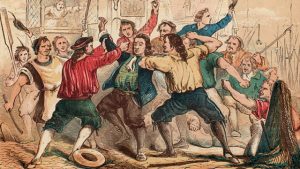The Glorious Revolution
Also called “The Revolution of 1688” and “The Bloodless Revolution,” took place from 1688-1689 in England. It involved the overthrow of Catholic King James II, who was replaced by his Protestant daughter Mary and her Dutch husband, William of Orange. Motives for the revolution were complex and included both political and religious concerns.
The event ultimately changed how England was governed, giving Parliament more power over the monarchy and planting seeds for the beginnings of political democracy.

The Glorious Revolution
King James II
King James II took the throne in England in 1685, during a time when relations between Catholics and Protestants were tense. There was also considerable friction between the monarchy and the British Parliament.
James, who was Catholic, supported the freedom of worship for Catholics and appointed Catholic officers to the army. He also had close ties with France—a relationship that concerned many of the English people.
In 1687, King James II issued a Declaration of Indulgence, which suspended penal laws against Catholics and granted the acceptance of some Protestant dissenters. Later that year, the King formally dissolved his Parliament and attempted to create a new Parliament that would support him unconditionally.
James’s daughter Mary, a Protestant, was the rightful heir to the throne until 1688 when James had a son, James Francis Edward Stuart, whom he announced would be raised Catholic.
The birth of James’s son changed the line of succession, and many feared a Catholic dynasty in England was imminent. The Whigs, the main group that opposed Catholic succession, were especially outraged.
The King’s elevation of Catholicism, his close relationship with France, his conflict with Parliament and uncertainty over who would succeed James on the English throne led to whispers of a revolt—and ultimately the fall of James II.
William of Orange
In 1688, seven of King James’s peers wrote to the Dutch leader, William of Orange, pledging their allegiance to the prince if he invaded England.
William was already in the process of taking military action against England, and the letter served as an additional propaganda motive.
William of Orange assembled an impressive armada for the invasion and landed in Torbay, Devon, in November 1688.
King James, however, had prepared for military attacks and left London to bring his forces to meet the invading army. Several of James’s own men, including his family members, deserted him and defected to William’s side. In addition to this setback, James’s health was deteriorating.
James decided to retreat back to London on November 23. He soon announced that he was willing to agree to a “free” Parliament but was making plans to flee the country due to concerns for his own safety.
In December, King James made an attempt to escape but was captured. Later that month, he made another attempt and successfully fled the country.

